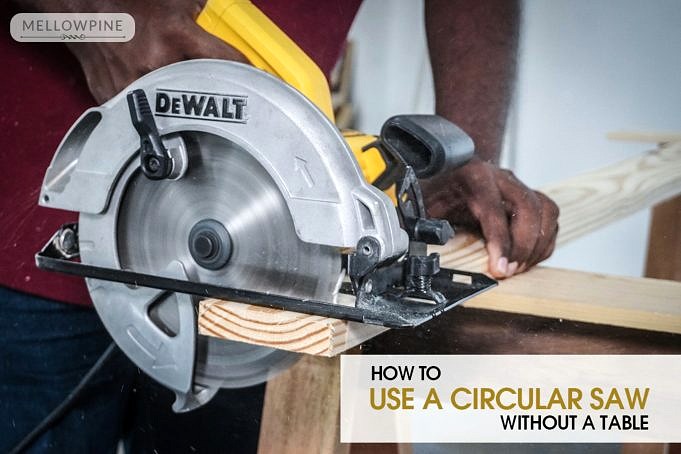These are the steps to using a circular saw with no table.
1. Get A Firm Grip On Your Saw.
You must first ensure that the circular saw is securely held in your hands. You shouldn’t try to use the circular saw without a table if you don’t feel comfortable with it.
2. Place The Saw On The Object You Are Cutting.
Once you feel comfortable with the circular saw’s grip, you can place the blade on the object you are cutting. Before you turn on the saw, make sure the blade is aligned with the area where you want to cut.
3. Get The Saw Started And Start Cutting.
It’s time to turn on the saw and start cutting. Slowly guide your blade through the material you are cutting. Be careful not to apply too much pressure.
4. Finalize Your Cut.
After you have cut your material, move the saw blade slowly through it. Keep your hand close to it at all times. If you let go, the saw could fly out of control.
5. Keep Your Saw Safe.
Last but not the least, ensure that your circular saw is stored safely after you’re done using it. It is important to unplug it and store it in a secure place that pets or children can’t reach.
You now know how to use a circularsaw without a table. Take safety precautions, and work slowly until you feel comfortable.
Safety Tips For Using A Circular Saw With No Table:
These are safety tips for using a circular saw with no table.
1. When operating a circular saw, always wear safety glasses.
2. Protect your hands from the saw blade by wearing gloves
3. Before you start using the saw, make sure that the surrounding area is free of obstructions.
4. Take extra care when cutting near your feet or around your body.
5. For best results and safety, keep the saw blade sharp.
6. After you are done, take out the plug and store it safely.
Some Common Mistakes:
These are the most common errors people make when using a circular-saw without a table.
1. The blade not being set at the right depth.
The most common mistake people make when using a circular-saw is not setting it to the right depth. This can cause the blade to become stuck in the workpiece, or make a poor cut. This can be prevented by making sure that the blade is adjusted before you begin to cut.
2. Inadequately securing the workpiece.
A common error is to not properly secure the workpiece before you begin cutting. This can lead to a dangerous or inaccurate cut. Before you begin to cut, make sure that the workpiece is securely secured.
3. Do not cut too close to the edges of the workpiece.
Another mistake is to cut too close the edge of the workpiece. This can lead to the blade becoming tangled and making it difficult, or even impossible, to complete the cut. This can be avoided by leaving a little space between the blade’s edge and the edge of your workpiece.
4. Rip cuts should not be made without a guide.
It is crucial to use a guide when making rip cuts to ensure the cut is straight. Incorrect cuts can be dangerous or difficult to correct. A guide, such as a straightedge and T-bar, is necessary to ensure a safe and accurate rip.
5. Cross-cutting is possible without making a relief cut first.
Cross-cutting is a process that requires a relief cut. This is a small, inverted cut. This allows the saw’s passage through the workpiece with no binding. Make a relief cut by aligning the blade with the scrap material and making a cut approximately 1/20 cm in depth.
6. You can make bevel cuts without first adjusting your blade angle.
It is crucial to adjust the blade angle before making bevel cuts. This will ensure that the bevel is cut at the right angle. Incorrect or dangerous bevel cuts can result. Simply turn the adjustment knob at the side of your saw to adjust the blade angle.
7. Do not check for sawdust buildup prior to making any cut.
If sawdust is allowed to accumulate, it can lead to dangerous conditions. This can also cause inaccurate cuts. These problems can be avoided by making sure you clear away all sawdust before cutting.
8. When operating the saw, it is important to use ear- and eye protection.
If not properly used, circular saws can prove dangerous and loud. When operating a circular saw, make sure you have adequate ear and eye protection. This will protect you against potential injuries.
FAQs:
How Can You Hold The Saw, The Material?
A: Hold the saw with your left hand on its handle and your right on the trigger. To hold the material in place, you can use a clamp.
What Cuts Can You Make Using A Circular Saw With No Table?
A: You can make rip, crosscut and bevel cuts.
What Are Some Of The Drawbacks To Using A Circular Saw With No Table?
A: Straight cuts may be more difficult for you. A circular saw that isn’t equipped with a table can be dangerous and you need to be careful.
Conclusion:
This is your complete guide to how to use a circularsaw without a table. This method is not easy, but it can be done with some patience and the right tools.
We hope that you found this article helpful.



